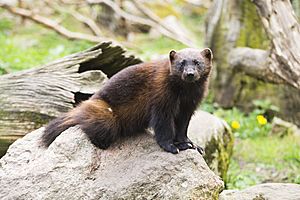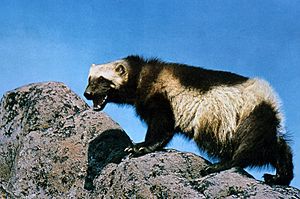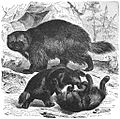Wolverine facts for kids
Quick facts for kids Wolverine |
|
|---|---|
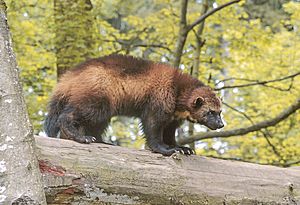 |
|
| Conservation status | |
| Scientific classification | |
| Genus: |
Gulo
|
| Species: |
gulo
|
| Subspecies | |
|
G. g. luscus |
|
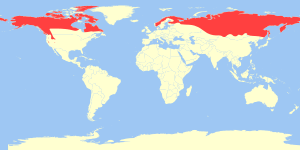 |
|
| Wolverine ranges | |
| Synonyms | |
|
Mustela gulo Linnaeus, 1758 |
|
The wolverine or glutton (Gulo gulo) is the largest member of the Mustelidae family (the weasels). It is a stocky and muscular carnivore, more like a small bear than other mustelids. The wolverine, a solitary animal, has a reputation for ferocity, and can kill prey many times larger than itself. It is a powerful and versatile predator and scavenger.
Contents
Physical characteristics
Anatomically, the wolverine is a stocky and muscular animal. With short legs, broad and rounded head, small eyes and short rounded ears, it more closely resembles a bear than it does other mustelids. Though its legs are short, its large, five-toed paws with crampon-like claws and plantigrade posture enable it to climb up and over steep cliffs, trees and snow-covered peaks with relative ease.
The adult wolverine is about the size of a medium dog
Wolverines have thick, dark, oily fur which is highly hydrophobic, making it resistant to frost. This has led to its traditional popularity among hunters and trappers as a lining in jackets and parkas in Arctic conditions. A light-silvery facial mask is distinct in some individuals, and a pale buff stripe runs laterally from the shoulders along the side and crossing the rump just above a 25–35 cm (10–14 in) bushy tail. Some individuals display prominent white hair patches on their throats or chests.
Like many other mustelids, it has potent anal scent glands used for marking territory and mate signaling. The smelly odor has given rise to the nicknames "skunk bear" and "nasty cat."
Wolverines, like other mustelids, possess a special upper molar in the back of the mouth that is rotated 90 degrees, towards the inside of the mouth. This special characteristic allows wolverines to tear off meat from prey or carrion that has been frozen solid.
Distribution
Wolverines live primarily in isolated arctic and alpine regions of northern Canada, Alaska, Siberia, and Scandinavia. they are also native to European Russia, the Baltic countries, northeast China and Mongolia. In 2008 and 2009, wolverines were sighted as far south as the Sierra Nevada, near Lake Tahoe, for the first time since 1922. They are also found in low numbers in the Rocky Mountains and northern Cascades of the United States, and have been sighted as far south and east as Michigan. However, most New World wolverines live in Canada.
Diet
Wolverines feed on almost every type of food that they can find: mice, rats, birds, bird eggs, reindeer and other large prey. Wolverines prefer to hunt larger prey in winter, when the snow slows down the prey and gives the wolverine an advantage.
Reproduction
Wolverines are highly territorial. Wolverines reproduce every two or three years. The female gives birth to one to three young (called kits) in a tunnel called a den deep underneath snowdrifts.
Protection
Humans are the wolverine’s main enemy. The wolverine’s thick, warm fur is used to manufacture the trim of a parka's hood or other winter clothes, as the dense guard hairs do not collect frost.
In February 2013, the United States Fish and Wildlife Service proposed giving Endangered Species Act protections to the wolverine largely because climate change (global warming) is whittling away its wintry habitat in the northern Rockies. Wolverines have poor eyesight but a keen sense of smell, they can smell prey 20 feet under the snow.
Images for kids
-
Wolverine skull from the Pleistocene of Germany at the Berlin's Natural History Museum
-
Wolverine with prey in Finland
See also
 In Spanish: Glotón para niños
In Spanish: Glotón para niños



